|
|
Recent Progress and Prospects of Ternary Layered Carbides/Nitrides MAX Phases and Their Derived Two-dimensional Nanolaminates MXenes
LI Mian, HUANG Qing
2020 Vol. 35 (1): 1–7
 Abstract
Abstract(
2447 )
 HTML
HTML(
177)
 PDF
PDF(6216KB)(
2532
)
In recent years, ternary layered carbide/nitride MAX phases and their derived two-dimensional nanolaminates MXenes have attracted extensive attention. The crystal structure of MAX phase is composed of Mn+1Xn unit interleaved with layers of A element. MAX phases combine good properties of metal and ceramic, which makes them promising candidates for high temperature structural materials, friction and wear devices, nuclear structural materials, etc. When etching the A-layer atoms of the MAX phase, the two-dimensional nanolaminates with the composition of Mn+1XnTx (Tx is surface termination), i.e. MXene, is obtained. MXenes have wide range of composition, and tunable physical and chemical properties, which endow them great potential in the applications of energy storage devices, electromagnetic shielding materials, and electronic devices, etc. In this paper, the research progress of MAX phase and MXene was introduced in terms of composition and structure, synthesis methods, and properties and application. Furthermore, the research prospects of this large family of materials were discussed.
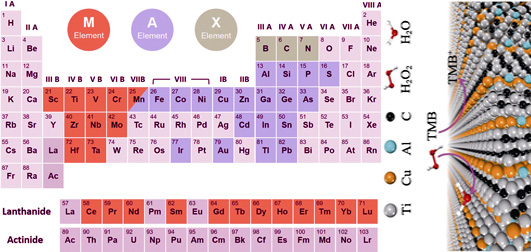
|
|
|
MXenes in Flexible Force Sensitive Sensors: a Review
YANG Yi-Na, WANG Ran-Ran, SUN Jing
2020 Vol. 35 (1): 8–18
 Abstract
Abstract(
1938 )
 HTML
HTML(
108)
 PDF
PDF(28262KB)(
2467
)
With the development of wearable flexible electronic technology, the demand for flexible sensor with high sensitivity and wide sensing range is gradually increasing. The application of suitable conductive materials with high electrical conductivity and high flexibility as sensitive materials for sensors is the key to obtain high performance sensors. In recent years, MXene materials have become very promising sensitive materials due to their good conductivity, high flexibility, good hydrophilicity, and controllable synthesis. The types of MXene-based flexible force sensors, microstructure design of sensitive materials, sensing performance, and sensing mechanism analysis have been expound and summarized in this paper.
|
|
|
Review on Metastable Phase Diagrams: Application Roles in Specialty Ceramic Coatings
HUANG Ye-Yan, XU Kai, WU Bo, LI Peng, CHANG Ke-Ke, HUANG Feng, HUANG Qing
2020 Vol. 35 (1): 19–28
 Abstract
Abstract(
1149 )
 HTML
HTML(
25)
 PDF
PDF(951KB)(
939
)
Phase diagrams, also known as equilibrium phase diagrams, serve as a road map for materials design. However, preparation process of coatings (such as Physical Vapor Deposition, PVD) is generally far from equilibrium and results in metastable phases. Thus, the CALPHAD (Calculation of Phase Diagrams) approach faces a challenge in calculating the metastable phase diagrams for PVD coating materials. Here we summarized the development of the modeling methodology for the metastable phase diagrams, where the model with critical surface diffusion distance established in recent years were highlighted. The CALPHAD approach, first-principles calculations coupled with high-throughput magnetron sputtering experiments were used to model the atomic surface diffusion, while only one key combinatorial experiment was performed to obtain the basic data for the computation, and the calculated metastable phase diagrams were confirmed by further experiments. Therefore, the database of the stable and metastable phase diagrams can be established, which will be used to guide the design of the ceramic coating materials by the relationship of composition, processing, microstructure, and performance. This model can also help to achieve the goal to shorten the time and reduce the costs of materials research and development.
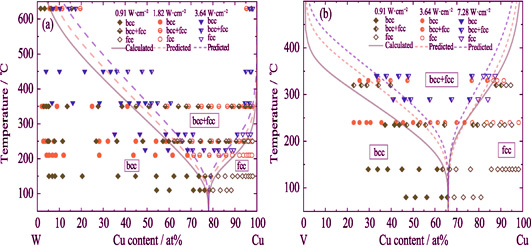
|
|
|
Research Progress on Multi-functional Integration MAX Phases Modified Continuous Fiber-reinforced Ceramic Matrix Composites
DANG Xiao-Lin, FAN Xiao-Meng, YIN Xiao-Wei, MA Yu-Zhao, MA Xiao-Kang
2020 Vol. 35 (1): 29–34
 Abstract
Abstract(
1098 )
 HTML
HTML(
57)
 PDF
PDF(1598KB)(
1477
)
Ceramic matrix composites (CMCs) are promising candidates for application in aeroengine, aerospace aircraft thermal protection systems, nuclear power system, and other fields. At present, CMCs are developing from structural bearing materials to multi-functional composites. MAX phases are a group of layered ternary ceramics with excellent plastic deformation capacity, high electrical conductivity, good irradiation resistance and ablation resistance. Besides strengthening and toughening CMCs, the introducing MAX phases into CMCs can effectively improve the anti-irradiation, anti-ablation and electromagnetic interference shielding performance, meeting requirements of multi-functional CMCs. This paper reviewed the progress on MAX phases modified CMCs, design mechanism and application prospect.
|
|
|
Phase Diagrams of Novel MAX Phases
CHEN Lei-Lei, DENG Zi-Xuan, LI Mian, LI Peng, CHANG Ke-Ke, HUANG Feng, DU Shi-Yu, HUANG Qing
2020 Vol. 35 (1): 35–40
 Abstract
Abstract(
1335 )
 HTML
HTML(
62)
 PDF
PDF(2658KB)(
1498
)
Phase diagrams are used as an indicator to estimate the thermodynamic stabilities of the novel MAX phases (Ti3AuC2, Ti3IrC2, Ti3ZnC2, Ti2ZnC). The phase diagrams of the Ti-Au-C, Ti-Ir-C, and Ti-Zn-C systems were obtained using the CALPHAD (Calculation of Phase Diagrams) approach coupled with ab initio calculations. The calculated results confirmed thermodynamic stabilities of the synthesized Ti3AuC2, Ti3IrC2, Ti3ZnC2, and Ti2ZnC MAX phases, which is in great agreement with the experiment information. The present work shows a systematic method to calculate the thermodynamic stability of the novel MAX phases, which can be used as guidance to synthesize more undiscovered MAX phases.
|
|
|
Hot-pressing Sintering of Double-A-layer MAX Phase Mo2Ga2C
JIN Sen, WANG Zuo-Tong, DU Ya-Qiong, HU Qian-Ku, YU Jian-Gong, ZHOU Ai-Guo
2020 Vol. 35 (1): 41–45
 Abstract
Abstract(
869 )
 HTML
HTML(
27)
 PDF
PDF(1037KB)(
971
)
Mo2Ga2C, a double-A-layer MAX, is reported to be films or powders. This paper researched the sintering properties of M2Ga2C powders to make dense bulk samples by vacuum hot pressing. It was found that 750 ℃ was a suitable sintering temperature, while higher temperature (850 ℃) resulted in decomposition of Mo2Ga2C yielding to main product of Mo2C. During sintering process at 750 ℃, its grain size did not increase obviously with sintering time, meanwhile the size of pores decreased markedly and the relative density increased significantly with the increasing sintering time. Additionally, the hot-pressed samples had obvious texture. Due to layering, some grains changed their orientations during sintering, of which most of the (00l) planes in the hot-pressed samples preferred to be perpendicular to the direction of hot press. Almost fully densed Mo2Ga2C bulk (relative density: 98.8%) was obtained by hot pressing at 750 ℃ for 8 h. This advantage of the method suggested that it can serve as a promising preparation for Mo2Ga2C, a double-A-Layer MAX.
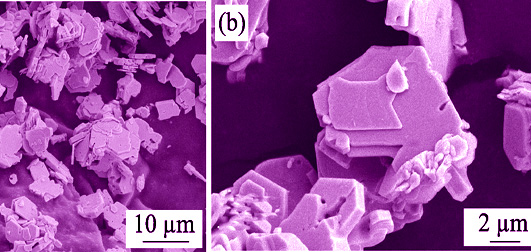
|
|
|
Ag/Ti3AlC2 Composites Prepared by Equal Channel Angular Pressing Followed by Heat Treatment
WANG Dan-Dan, TIAN Wu-Bian, DING Jian-Xiang, MA Ai-Bin, ZHANG Pei-Gen, HE Wei, SUN Zheng-Ming
2020 Vol. 35 (1): 46–52
 Abstract
Abstract(
638 )
 HTML
HTML(
21)
 PDF
PDF(4220KB)(
818
)
Equal channel angular pressing (ECAP) followed by heat treatment was carried out to prepare Ag/Ti3AlC2 composites. Effects of heat treatment on the electrical resistivities and mechanical properties of the Ag/Ti3AlC2 composites were investigated. Results show that ECAP effectively densifies the Ag/Ti3AlC2 compacts, and layered Ti3AlC2 particles are delaminated and aligned due to shearing effect during ECAP. Alignment of Ti3AlC2 particles resulted in anisotropy of electrical and mechanical properties of the composites. Perpendicular to the alignment of Ti3AlC2 particles displayed high resistivity and compressive strength. Moreover, resistivity and compressive strength increased with following heat treatment, yielding the maximum at 800 ℃. These increments are attributed to the enhanced interfacial reactions between Ag and Ti3AlC2 at high temperatures. Findings in this study indicate that densification and microstructural control of Ag/MAX composites can be achieved simultaneously by ECAP, while the following heat treatment can tailor their properties.
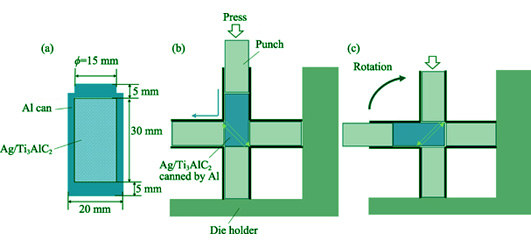
|
|
|
Analysis on Phase Stability and Mechanical Property of Newly-discovered Ternary Layered Boride Cr4AlB4
QI Xin-Xin, SONG Guang-Ping, YIN Wei-Long, WANG Ming-Fu, HE Xiao-Dong, ZHENG Yong-Ting, WANG Rong-Guo, BAI Yue-Lei
2020 Vol. 35 (1): 53–60
 Abstract
Abstract(
715 )
 HTML
HTML(
27)
 PDF
PDF(2732KB)(
1018
)
As newly-discovered member of the MAB phases, Cr4AlB4 has much potential for high-temperature structural applications due to possible formation of a protective oxide scale. By use of “linear optimization procedure” and theoretical model of “bond stiffness” based on first-principle calculations, the phase stability and mechanical behavior of Cr4AlB4 were investigated. No imaginary frequencies in phonon dispersion indicate the intrinsic stability. The lower energy as compared with the set of other competing phases also shows the thermodynamic stability. Based on the quantificationally calculated bond stiffness by use of the model of “bond stiffness”, strong covalent bonding is present between Cr and B atoms as well as B and B atoms, while the Cr-Al (625 GPa) and B-Al (574 GPa) bond is relatively weak. It follows that Cr4AlB4 can be described as layered structure of strong covalently bonded Cr-B blocks interleaved by Al atomic planes where the bonding is relatively weak, similar to the well-known MAX phases, which demonstrates the similar damage tolerance and fracture toughness of Cr4AlB4 with the MAX phases.
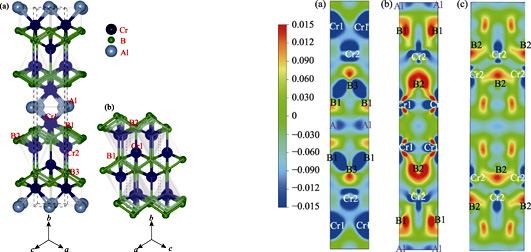
|
|
|
Fabrication and Mechanical Property of ZrC/Cr2AlC Composites
XU Wei-Min, LI Shi-Bo, HU Shu-Jun, JIANG Ji-Peng, YU Wen-Bo, ZHOU Yang
2020 Vol. 35 (1): 61–64
 Abstract
Abstract(
648 )
 HTML
HTML(
27)
 PDF
PDF(5680KB)(
781
)
Cr2AlC is a representative material in MAX phase family due to its combination of metallic and ceramic properties such as high electrical conductivity, high thermal conductivity, resistance to corrosion, good oxidation resistance. To further improve performance of Cr2AlC, ZrC as a reinforcement was selected to reinforce Cr2AlC matrix composites by hot pressing technique. Influence of ZrC content on the mechanical property of ZrC/Cr2AlC composites has been investigated. The results showed that 10vol% ZrC/Cr2AlC composite improved flexural strength (715 MPa) and Vickers hardness (7 GPa) by 80% and 106%, respectively, as compared with those of pure Cr2AlC material. Date from this study indicate that Cr2AlC MAX possesses broaden application potential.
|
|
|
Adsorption of Eu(III) on Alkalized Ti3C2Tx MXene Studied by Batch Experiment and Its Mechanism Investigation
SONG Huan, WANG Lin, WANG Hong-Qing, SHI Wei-Qun
2020 Vol. 35 (1): 65–72
 Abstract
Abstract(
829 )
 HTML
HTML(
19)
 PDF
PDF(1144KB)(
1246
)
In order to rapidly remove Eu(III) from aqueous solution, an alkalized two-dimensional titanium carbide, Na-Ti3C2Tx, was successfully prepared by treating inorganic two-dimensional transition metal carbide (MXene) with NaOH. Adsorption behavior of Eu(III) on Na-Ti3C2Tx was systematically investigated by batch experiments. The results show that the adsorption process is greatly affected by pH and ionic strength of the solution, and reached equilibrium within 5 min. Based on Langmuir model fitting results, the maximum adsorption capacity of Eu(III) on Na-Ti3C2Tx was calculated to be 54.05 mg/g at pH 4.0 under 298 K. The thermodynamic results suggested that the adsorption process was a spontaneous and endothermic reaction. The adsorption mechanism was further analyzed by energy dispersive X-ray spectroscopy (EDS), powder X-ray diffraction (XRD) and extended X-ray absorption fine structure spectroscopy (EXAFS). These data revealed that Na + ions inside MXene galleries were exchanged by Eu 3+ ions and Eu(III) existed dominately in under outer-sphere surface complexation after adsorption under acidic pH conditions, but in inner-sphere surface complexation under near-neutral pH conditions. Due to its cost-effective prepatation and excellent sorption performance, Na-Ti3C2Tx may be a promising candidate for the efficient removal of trivalent minor actinides and lanthanides from radioactive wastewater.
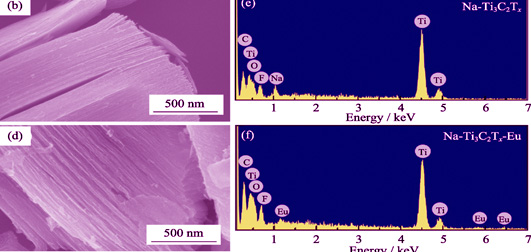
|
|
|
Theoretical Studies on the Modulation of the Electronic Property of Ti2CO2 by Electric Field, Strain and Charge States
WANG Chang-Ying, LU Yu-Chang, REN Cui-Lan, WANG Gang, HUAI Ping
2020 Vol. 35 (1): 73–78
 Abstract
Abstract(
773 )
 HTML
HTML(
16)
 PDF
PDF(1896KB)(
819
)
As a new two-dimensional transition metal carbides, MXene has various potential applications, such as energy storage, catalyst, composite material, and luminescent materials for their excellent physical and chemical properties. The element doping, geometrical defect, surficial functionalization, external electric field, and external strain can be used as effective methods for modulation of their properties. Ti2CO2, the thinnest Ti-based MXene, exhibits semiconducting character. The effects of electric field on the band structure of perfect primitive Ti2CO2 were explored in this work. The results revealed that the band gap of perfect primitive Ti2CO2 decreased with the increasing electric field. Carbon (C) vacancy in Ti2CO2 MXene was easily produced during the preparation process. Further investigation showed that the tensile strain could be used to regulate the conductivity of this system as the bands around the Fermi energy become smoother with increasing tensile strain. The investigation of charged C vacancy doped 2×2×1 Ti2CO2 indicated that its Fermi energy decreased with the increase of charge state. When it was +2 charged, the C vacancy doped 2×2×1 Ti2CO2 exhibited semiconducting character and owned a direct band gap of 0.489 eV.
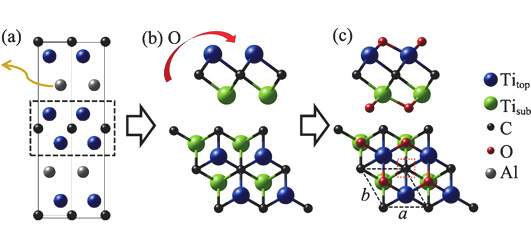
|
|
|
PtRu Particles Supported on Two-dimensional Titanium Carbide/Carbon Nanotubes: Preparation and Electrocatalytic Properties
LI Ya-Hui, ZHANG Jian-Feng, CAO Hui-Yang, ZHANG Xin, JIANG Wan
2020 Vol. 35 (1): 79–85
 Abstract
Abstract(
823 )
 HTML
HTML(
22)
 PDF
PDF(15097KB)(
1430
)
Direct methanol fuel cells have good application prospects due to their advantages of convenient operation, high conversion efficiency, low operating temperature, low pollution, and easy storage and easy transportation of liquid fuel. However, existing anode catalysts have shortcomings such as low catalytic activity and poor resistance to CO toxicity which restrict its commercial application. In this study, a series of PtRu/(Ti3C2Tx)0.5-(MWCNTs)0.5 anode catalyst materials with different Pt and Ru ratios were prepared by three-step method. Ti3C2Tx was obtained by HF corrosion of Ti3AlC2, and acidified multi-walled carbon nanotubes (MWCNTs). After the compounding, Pt and Ru particles are supported by a solvothermal method. The synergistic relationship of Ru and Pt atoms was analyzed by XRD, SEM, EDS, TEM, and XPS. The results show that the Ru atoms are mixed with the Pt atoms to form PtRu bimetallic alloy with a particle size of about 3.6 nm. The electrochemical results show that the Pt1Ru0.5/(Ti3C2Tx)0.5-(MWCNTs)0.5 catalyst has the best electrochemical performance. Its electrochemical active area (ECSA) is 139.5 m 2/g, and positive peak current density is 36.4 mA/cm 2.
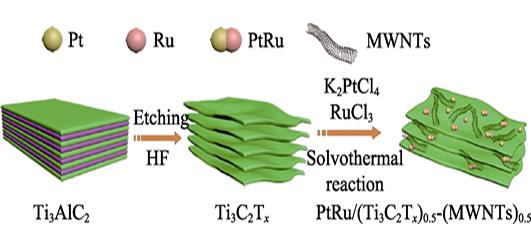
|
|
|
Controlled Synthesis of Core-shell Structured Mn3O4@ZnO Nanosheet Arrays for Aqueous Zinc-ion Batteries
LI Meng-Xia, LU Yue, WANG Li-Bin, HU Xian-Luo
2020 Vol. 35 (1): 86–92
 Abstract
Abstract(
1033 )
 HTML
HTML(
43)
 PDF
PDF(5546KB)(
1184
)
Manganese-based oxides are promising cathode materials for zinc-ion batteries. However, these materials often suffer from rapid capacity fade due to structure collapse during charge and discharge processes. Here, we report that core-shell structured Mn3O4@ZnO nanosheet arrays are synthesized on the carbon cloth, combining microwave hydrothermal process with atomic layer deposition. With an optimized thickness of ZnO coating layer, the capacity retention of the as-formed Mn3O4@ZnO nanosheet arrays exhibits 60.3% over 100 discharge-charge cycles at a current density of 100 mA·g -1. It is demonstrated that the introduction of ZnO layers is beneficial to maintain the microstructure and improve the structural stability of the Mn3O4 electrode material during the discharge-charge process, benefiting from avoiding direct contact with the electrolyte. The design of the well-defined core-shell structure provides an effective way to develop high-performance manganese-based oxide cathode materials for zinc-ion batteries.
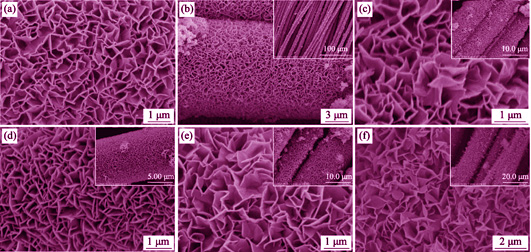
|
|
|
Monolayer Ti3C2Tx Nanosheets with Different Lateral Dimension: Preparation and Electrochemical Property
MA Ya-Nan, LIU Yu-Fei, YU Chen-Xu, ZHANG Chuan-Kun, LUO Shi-Jun, GAO Yi-Hua
2020 Vol. 35 (1): 93–98
 Abstract
Abstract(
1058 )
 HTML
HTML(
42)
 PDF
PDF(5811KB)(
1357
)
Recently, a new type of 2D transition metal carbides or nitrides (MXene) has attracted wide attention due to its large specific surface area, good hydrophilicity, metallic conductivity and other physical and chemical properties. 2D Ti3C2Tx MXene was obtained by etching Al layer of Ti3AlC2 with LiF and HCl and then mechanically delaminated. And the monolayer Ti3C2Tx nanosheets with lateral dimension of 625 and 2562 nm can be prepared by changing the intensity and way of mechanically delamination, as well as the centrifugation rate and time. Then their morphology, structure, composition, and electrochemical performance of Ti3C2Tx were studied. The results showed that the specific capacitance of Ti3C2Tx with smaller lateral size (<1 μm) can reach 561.9 F/g, higher than that of reported graphene, carbon tube and MnO2 in the repotted literatures. And the Ti3C2Tx electrode still remained 96% of the initial specific capacitance after 10 4 testing cycles.
|
|
|
Bioinspired Ultrathin MXene/CNC Composite Film for Electromagnetic Interference Shielding
LIU Zhang-Shuo, LIU Ji, DAI Yang, LI Xiao-Feng, YU Zhong-Zhen, ZHANG Hao-Bin
2020 Vol. 35 (1): 99–104
 Abstract
Abstract(
1254 )
 HTML
HTML(
41)
 PDF
PDF(2247KB)(
1675
)
Electromagnetic interference (EMI) shielding films with excellent mechanical properties are highly promising for applications in flexible devices, automotive electronics and aerospace. Inspired by the excellent mechanical properties of nacre derived from its micro/nanoscale structure, high-performance MXene/Cellulose nanocrystals (CNC) composite films were prepared by simple solution blending and followed vacuum-assisted filtration process. The presence of CNC significantly improves the mechanical properties with tensile strength increasing from 18 MPa to 57 MPa and toughness improving from 70 kJ/m 3 to 313 kJ/m 3. Meanwhile, the composite film still exhibits high electrical conductivity (up to 10 4 S/m) and excellent EMI shielding efficiency (over 40 dB) with a small thickness of 8 μm.
|
|
|
Ge Nanoparticles in MXene Sheets: One-step Synthesis and Highly Improved Electrochemical Property in Lithium-ion Batteries
GUO Si-Lin, KANG Shuai, LU Wen-Qiang
2020 Vol. 35 (1): 105–111
 Abstract
Abstract(
1178 )
 HTML
HTML(
56)
 PDF
PDF(10073KB)(
1252
)
Ge nanoparticles were synthesized uniformly on MXene sheets via a one-step chemical solution method. Morphology of Ge/MXene was characterized by SEM and TEM. Formation process and optimized synthesis condition was analyzed carefully. Ge/MXene was used as anode for lithium-ion batteries. Their electrochemical performances, including capacity, rate and cycling stability, were tested and evaluated. Ge/MXene exhibited a greatly improved capacity of 1200 mAh/g during the first hundred cycles at 0.2C with a loading of 1 mg/cm 2. A capacity of 450 mAh/g at a higher loading of 2 mg/cm 2 was obtained after 100 cycles. The excellence in electrochemistry is attributed to the high conductivity of MXene and its accommodable interlayer space.
|
|
|
Fabrication of Planar Porous MXene/Carbon Composite Electrodes by Simultaneous Ammonization/Carbonization
ZHANG Tian-Yu, CUI Cong, CHENG Ren-Fei, HU Min-Min, WANG Xiao-Hui
2020 Vol. 35 (1): 112–118
 Abstract
Abstract(
1037 )
 HTML
HTML(
65)
 PDF
PDF(2390KB)(
1319
)
As a new class of two-dimensional transition metal carbon/nitride, MXenes have been proven to be a kind of pseudocapacitive supercapacitor electrode materials with excellent electrochemical property, and hold promise in practical use in the near future. In practical applications, it is required to make the electrode materials into planar porous electrodes for capacitor assembly. Herein, a simultaneous ammonization/carbonization method is proposed for the preparation of MXene planar porous electrode. Filter paper was used as a planar porous template, and MXene was coated on the fibers of the filter paper by means of dipping-drying, and then heat-treated in an ammonia atmosphere to obtain MXene/carbon planar porous composite electrodes. Analysis results show that the MXene nanosheets are uniformly coated on the carbonization-derived carbon fibers of the filter paper. When immersed 5 times, the areal capacitance reaches 403 mF/cm 2 at a scan rate of 2 mV/s. After the composite electrode was tested for 2500 times in a galvanostatic charge-discharge cycle at a current density of 10 mA/cm 2, the capacitance was almost the same as the initial capacitance, showing good rate performance and cycle stability. The MXene/carbon planar porous composite electrodes prepared by simultaneous ammonia/carbonization exhibit excellent electrochemical performance without using either polymer binder or metal current collector.
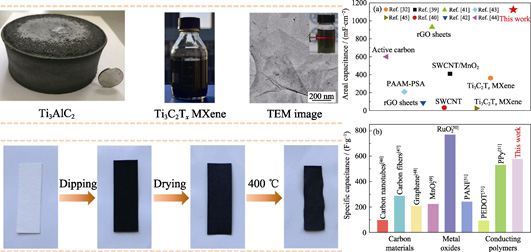
|
|
|
Manganese Dioxide Morphology on Electrochemical Performance of Ti3C2Tx@MnO2 Composites
LI Xue-Lin, ZHU Jian-Feng, JIAO Yu-Hong, HUANG Jia-Xuan, ZHAO Qian-Nan
2020 Vol. 35 (1): 119–125
 Abstract
Abstract(
940 )
 HTML
HTML(
50)
 PDF
PDF(6409KB)(
1104
)
Ti3C2Tx@MnO2 composites with different morphologies were prepared by liquid-phase coprecipitation and hydrothermal method using Ti3C2Tx@PDA as matrix, KMnO4 as manganese source, CTAB or PEG as surfactant. Effect of MnO2 morphology (δ-MnO2 nanofragments, α-MnO2 nanorods, α-MnO2 nanoflowers and α-MnO2 nanowires) on phase structure and electrochemical performance of Ti3C2Tx was analyzed by FE-SEM, XRD, Raman, FT-IR, BET, and electrochemical measurements. The results show that Ti3C2Tx@α-MnO2 nanowires possesses better comprehensive electrochemical properties (340.9 F?g -1 at 2 mV?s -1), nearly 2.5 times higher than using CTAB, and smaller charge transfer resistance, as well as excellent cycle stability.
|
|
|
Ti3C2Tx/Wood Carbon as High-areal-capacity Electrodes for Supercapacitors
LI Teng-Fei, HUANG Lu-Jun, YAN Xu-Dong, LIU Qing-Lei, GU Jia-Jun
2020 Vol. 35 (1): 126–130
 Abstract
Abstract(
951 )
 HTML
HTML(
32)
 PDF
PDF(5298KB)(
1059
)
MXenes—two-dimensional (2D) compounds generated from layered bulk materials, have attracted significant attention in energy storage fields. However, low mass loading of MXenes results in low areal capacity and impedes the practical use of MXenes electrodes. Inspired by natural basswood, an ideal architecture with natural, three-dimensionally (3D) aligned open microchannels was developed for high Ti3C2Tx mass loading. Compared with reported Ti3C2Tx electrode structure, the 3D porous carbon matrix has several advantages including low tortuosity, high conductivity and good structure stability. The Ti3C2Tx assembled with the wood carbon can deliver a high areal capacity of 1983 mF/cm 2 at 2 mV/s with a high Ti3C2Tx mass loading of 17.9 mg/cm 2 when used as electrode for supercapacitors. This work provides a new strategy to develop 3D porous electrodes for MXenes, which can achieve high areal capacity.
|
|
|
Enzyme-MXene Nanosheets: Fabrication and Application in Electrochemical Detection of H2O2
MA Bao-Kai, LI Mian, CHEONG Ling-Zhi, WENG Xin-Chu, SHEN Cai, HUANG Qing
2020 Vol. 35 (1): 131–138
 Abstract
Abstract(
1507 )
 HTML
HTML(
56)
 PDF
PDF(4781KB)(
1629
)
Two-dimensional MXene nanosheets with vertical junction structure was employed for easy immobilization of horse radish peroxidase enzymes to fabricate the electrochemical hydrogen peroxide (H2O2) biosensor. The synthesized MXene nanosheets exhibited large specific area, excellent electronic conductivity and good dispersion in aqueous phase. Horse Radish Peroxidase (HRP) enzymes molecules immobilized on MXene/chitosan/GCE electrode demonstrated good electrocatalytic activity toward reduction of H2O2. The fabricated HRP@MXene/chitosan/GCE biosensor exhibited a wide linear range from 5 to 1650 μmol?L -1, a limit of detection of 0.74 μmol?L -1 and good operation stability. The fabricated biosensor was successfully employed for detection of trace level of H2O2 in both solid and liquid food.
|
|
|
Mn 2+ Intercalated V2C MXene for Enhanced Sodium Ion Battery
WEI Shi-Qiang, WANG Chang-Da, ZHANG Peng-Jun, ZHU Ke-Fu, CHEN Shuang-Ming, SONG Li
2020 Vol. 35 (1): 139–144
 Abstract
Abstract(
1417 )
 HTML
HTML(
56)
 PDF
PDF(1211KB)(
1702
)
Mn 2+ intercalation strategy to optimize the sodium storage performance of V2C MXene was studied. The intercalated Mn 2+ not only enlarged the interlayer spacing of V2C MXene but also formed a V-O-Mn covalent bond, which was beneficial to stabilize the structure of V2C and inhibit the structural collapse caused by volume change during Na + decalation or intercalation. As a result, the intercalated V2C MXene (V2C@Mn) electrode showed a high specific capacity of 425 mAh·g -1 at the current density of 0.05 A·g -1, and 70% retention after 1200 cycles. This result clearly suggests that cations intercalated MXene has a great prospect in Na + storage.
|
|